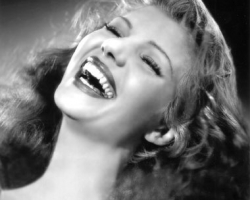In 1913 Elisa and Eduardo Cansino emigrated from Spain to the USA. Eduardo, 17, and his 19-year-old sister were extraordinarily talented dancers, calling themselves the Dancing Cansinos. They were featured in 1916’s Broadway musical “Follow Me.” During this show Eduardo met and married Volga Hayworth. On Oct. 17, 1918 their daughter Margarita was born. Sons Eduardo Jr. and Vernon followed within three years.
Little Margarita began dance training at age 4.
In 1926 Warner Brothers hired the Dancing Cansinos to perform in a movie. Encouraged, Eduardo decided to move his family to Hollywood. But Elisa refused to move, thereby breaking up the dancing duo. Eduardo’s poor English, though, destroyed his value in the new talkies. He rallied by opening a dance school.
In 1931 Eduardo resurrected the Dancing Cansinos act, using his daughter as his partner. At age 12, Margarita became an important part of the family’s finances.
Prohibition had resulted in evasions by the public in getting access to alcohol. For instance, casinos were run on ships anchored outside of the three-mile limit from the California coast.
The Dancing Cansinos became regularly employed on these floating casinos. Eduardo pulled Margarita out of school, lied about her age and passed her off as his wife during the performances.
Margarita’s life was miserable. Her mother had become an alcoholic. Her father became drunk at the shows and gambled away their earnings. He made Margarita fish for the family’s food between performances. If at any time Margarita displeased him, Eduardo beat her, making sure her bruises would not be visible to an audience.
The Foreign Club, Tijuana’s popular night spot, engaged the Dancing Cansinos and the family moved to Chula Vista, where there was only a 20-minute commute to the border. In 1933 they lived at 319 First Ave. (now Fifth Avenue).
Eduardo taught Margarita to be sexually provocative during her performances. After the gig with the Foreign Club ended, the Cansinos moved back to Hollywood, and Eduardo became a director of dance for films. A reengagement in Tijuana brought the Cansinos back to live in Chula Vista.
Shy, mysterious Margarita became an object of curiosity to the neighborhood children, and they observed things their parents never knew about.
Loretta Parkin and her brother were playmates with Margarita’s brothers, but “strange, silent Margarita never joined their games, although she often sat on the front porch staring silently ahead…” Parkin recalled in a book about Hayworth.
“I felt sorry for her because all her recreation was just sitting on the front porch. That was all she did. For Rita there was no life, no school, no friends, no girlfriends. She was never allowed any of these things. Just sitting, sitting, sitting,” Parkin said.
But in the evenings, Margarita became a fiery and erotic stage presence at Agua Caliente, and after performances, the Cansinos would be invited to the tables of “Hollywood big-wigs.” She caught their interest. In 1935 at age 16, Margarita performed a “decidedly sensuous dance sequence set on a gambling ship” in the movie “Dante’s Inferno.” Early that year the family moved back to Hollywood. Thus began, on Feb. 11, the illustrious screen career of the gorgeous, and now renamed, Rita Hayworth.
Susan Walter writes about history in the South Bay. Her column appears the last week of the month.

